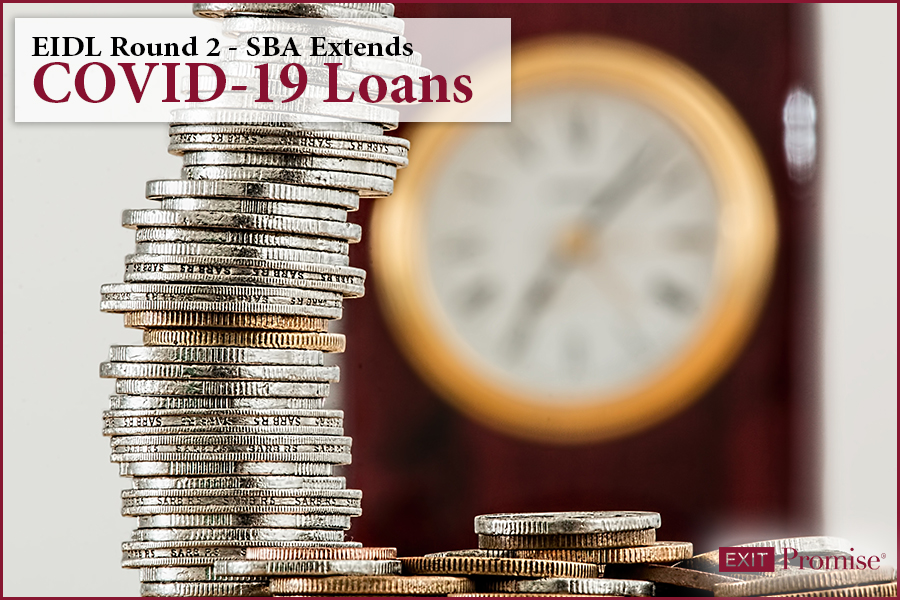- Maximizing After Tax Proceeds When Selling Your Business - June 7, 2024
- Understanding the Accredited Investor Rule 501 of Regulation D - February 27, 2024
- Which is Best – Business Broker, M&A Advisor, or an Investment Banker? - October 2, 2023

Have a Question?
Ask your Question below!
One of our investors or advisors will answer.
The Consolidated Appropriations Act of 2021 replenished the pool of EIDL money by $20Billion and the application deadline for the Small Business Administration’s (SBA) Economic Injury Disaster Loan (EIDL) program has been extended to December 31, 2021. This extension, unofficially referred to as the EIDL Round 2, is welcome news for many business owners suffering as the result of the ongoing pandemic.
The extension is part of the second Covid-19 Relief Bill signed into law on December 27th, 2020. While this part of the relief bill extends most of the provisions in the first EIDL program, little attention has been paid to it by the press. For this reason, we feel it is worthy to highlight its key provisions and the rules for the new targeted EIDL Advance, which is a grant.
EIDL Loan Program Key Provisions
- Eligible Borrowers include small business owners and agricultural businesses with 300 or less employees, non-profits in the US states, Washington D.C. and territories who have suffered a temporary loss of revenue due to the pandemic.
- Use of Proceeds include working capital, operating expenses such as payroll, healthcare insurance premiums, rent, utilities, existing fixed debt payments, including federal business debt payments as well as the prepayments of commercial debt.
- 30 Payment Term at 3.75% Fixed Rate for businesses and 2.75% Fixed Rate for nonprofits, with no pre-payment penalty.
- Up to $2,000,000 may be borrowed, effective September 8, 2021. If a borrower was previously subject to the former lower loan limits of $150,000 and $500,000, they may apply for an increase based on the new 24 month computation for qualification. To apply, login to your SBA EIDL portal and look for the button that says Request an Increase. If the button is not found on your portal main page, you will need to send the SBA an email to Co***********************@sb*.gov with the “EIDL Increase Request for (insert your)10-digit application number” in the subject line. Include in the body of your email the following information:
- Loan Application Number
- Loan Number (not the same as your loan application number!)
- Full Business Name
- Business Address
- Business Owner(s) names
- Phone Number
- No Collateral Requirement if EIDL is less than $25,000; If more than $25,000 the SBA files a General Security Agreement (UCC-1) form to collateralize the business’ assets. If EIDL is $200,000 or more, business owner collateral is required.
- Deferred payments will be granted for loans made in 2020 as well as 2021 for 24 months from the date of the note. During this deferred payment period interest on the note will accrue.
- For those businesses that received Emergency EIDL Advance (or Grants), the grant may be excluded from gross income on its tax return and is no longer required to be repaid if the business also received a PPP Loan which is fully forgiven. Prior to the Consolidated Appropriations Act of 2021, if a PPP Loan was forgiven and the business also received an EIDL grant, the EIDL grant would be converted to a loan under the PPPL terms.
New Targeted EIDL Advance Grants
When the original EIDL program launched in mid-2020, it included for applicants an Advance Grant amount of up to $10,000. To qualify for the first grant, a business would apply for the EIDL via the SBA’s website and within a matter of a few days would receive a deposit in its business bank account equal to $1,000 multiplied by the number of full-time employees (up to $10,000). By mid July, 2020, the SBA stopped making these grants because it ran out of money earmarked for the grant program.
The Consolidated Appropriations Act 2021 provides for an additional $20 Billion in grants to be distributed through the new targeted EIDL Advance program.
This time, an applicant must qualify for the EIDL advance as follows:
- There must be an economic loss of more than 30% measured by comparing any eight-week period between March 2, 2020 and December 31, 2020 to the comparable eight-week period during 2019; and
- The business must be located in a low-income community; and
- The business may not employ more than 300 employees; and
- The business must apply to the SBA by December 31, 2021. * AS OF MAY 28, 2021, THE SBA ANNOUNCED THE EIDL GRANT PROGRAM IS OUT OF MONEY. IN THE FINAL WEEK OF JUNE 2021, THE SBA OPENED THE EIDL GRANT PROGRAM AGAIN. SEE BELOW FOR UPDATED INSTRUCTIONS TO APPLY:
If an eligible business (see above) previously applied for the EIDL, they no longer need to wait for an email to be considered for the Targeted Advance grant. Instead, the applicant should call the SBA’s Disaster Customer Service Center at 800 659-2955 or email Ta*************@SB*.gov to request an invitation.
If an eligible business did not apply for the EIDL program and would like to apply for the Targeted (or Supplemental) Advance grant, the should apply on the SBA Disaster Loan Assistance Application portal here.
Similar to the first round, it is not necessary for the business to accept the EIDL if it’s ultimately offered by the SBA. The business may keep the EIDL grant money received.
The Targeted EIDL Advance is being made available to two groups of applicants. The first group are those businesses and non-profits that received less than $10,000 the first time and the second group are those businesses and non-profits that did not receive any EIDL Advance due to the funds being exhausted.
If the business currently meets the eligibility criteria above, the SBA will send an email invitation directly to the applicants who did not receive the full $10,000 EIDL Advance or received no advance due to lack of funding in the summer of 2020. Upon receipt of the email from the SBA, the applicant may apply for the Targeted EIDL Advance.
It appears the SBA has lifted the former requirement that the applicant will be eligible to apply for the new, Targeted EIDL Advance only if they had applied for the EIDL program on or before December 27, 2020.
How to Apply for the EIDL Loan Program (not the EIDL Advance Grant)
As of July 1, 2021, the SBA has opened up EIDL Program applications again which means first-time applicants may apply on the SBA’s website here.
Below are a few tips based on our clients’ experiences when applying for the EIDL program:
In our practice, we’ve been involved with a number of clients who applied for the EIDL round one. A few of them did so in haste and spent the better part of the last six or so months trying to resolve their sloppy application. The SBA will reject an EIDL application if anything on the application doesn’t line up properly.
When you apply for the EIDL program, be certain the name of the business and its business address matches exactly what’s on your federal tax return and your business bank account. And verify the EIN used in the application matches the EIN on your business tax return.
Applicants often make the mistake of guestimating their 2019 gross revenue and cost of goods sold. Do not make this mistake. Look very carefully at your 2019 federal tax returns and find the figures in the Gross Revenue and Cost of Goods Sold boxes. Again, if you don’t get this right, your application will likely be rejected by the SBA.
The Gross Revenue and Cost of Goods Sold figures will drive the amount of EIDL because it determines the amount of working capital you need to operate your business. The EIDL loan is based on your business’ required working capital so it’s very important to get it right.
You should also be prepared to deliver the IRS Form 4506-T for your business. This form allows the IRS to pull your federal tax forms for your business for them to review. Technically, it’s the tax transcripts they will review. They will be looking at whether you’ve filed your and paid your federal taxes.
And if you get past these couple of hurdles, the SBA will also pull the personal credit scores from the credit bureaus for any shareholder (or other owner) holding 20% or more ownership stake in the business. If your credit score is low, it’s unlikely you will be approved for the EIDL loan.
You will also have to prove your identity with a valid photo ID and provide the SBA with a cancelled check for the business. They will verify the bank you’ve identified to receive your EIDL grant and/or loan proceeds is a legitimate business bank account. There was a lot of fraud in the EIDL first round so the SBA is being extra cautious — which is a good thing.














After all EIDL loan funds are spent on allowed expenses (payroll) is the business still under restrictions as to how it uses other income? For instance to pay dividends or employee year end bonuses?
Hi Jackson,
Payroll expenses and employee year-end bonuses are permitted expenses for EIDL fund because they are part of the normal working capital required to operate a business.
Corporation’s dividend payments to its shareholders are not permitted under the EIDL program.
All the best…